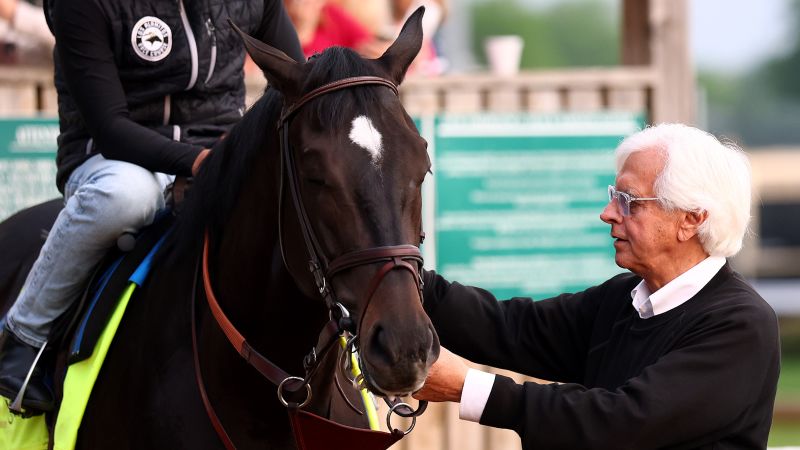CNN
—
The last 12 months have been a whirlwind for Armand “Mondo” Duplantis.
Having already been one of the most recognizable faces in track and field, the Swedish pole-vaulter catapulted himself to even greater heights in a remarkable year for the 25-year-old.
Not only did he break his own world record to win his second Olympic gold medal in Paris last summer, but he became engaged to his long-time girlfriend and also has made his first foray in the music scene with a debut single.
His achievements were recognized at last month’s Laureus World Sports Awards in Madrid, winning the Sportsman of the Year award to become just the second track and field athlete to do so after Usain Bolt.
And after what he calls a “life-changing” year, Duplantis says there is more to come.
“I do still have that confidence that going into (the 2028 Olympic Games) in LA, I’m going to be in even better shape. I can jump even higher,” Duplantis told CNN Sports in an exclusive interview. “I’m going to do something just like that, make a big splash, can maybe break a record again and something like that.”
When it comes to dominating a single sport, no one has done it quite like Duplantis in pole vaulting in recent years.
He is one of only three men to hold the pole vault world record in the 21st century, setting 11 world records on his own since first doing so in 2020 as he’s singlehandedly raised the level from 6.17m to 6.27m over five seasons.
Duplantis went from top-level athlete to global superstar at the 2024 Summer Olympics in Paris when he broke the world record of 6.25m on his third and final attempt in front of the world. In February, he needed just one attempt to break the record again. Duplantis revealed to CNN that he is confident he will reach the 6.30m (roughly 20.67 feet) mark in the near future.

That moment in France came with a huge increase in attention on Duplantis’ achievements, gaining a large amount of followers on social media and shooting to international stardom; he also proposed to girlfriend Desiré Inglander during a photoshoot for Vogue Scandinavia in October last year.
He admits that the added attention he’s received has made him think about his place in the sporting world, in particular around pole vaulting, while he also tries to remain grounded.
“I think maybe you can see it even now more than ever that things can get a bit separated in track and field and I want pole vaulting to be able to stand on its own two legs. I think that’s very important,” he told CNN Sports. “It’s pretty easy to get caught up if you think about too many people that are following you or looking at you.
“I think that’s a weird thing to conceptualize. I try to just go about my business. I know that I’m a good guy and I just try to do things that I feel like are right and I guess hopefully lead by a good example, which is for the most part I think the most inspiring thing is just a real passion and love for the sport and doing what I love from the very beginning and hopefully that can inspire.”
He is currently on a run of 28 straight victories and, during his time at the top of the sport, Duplantis has collected two Olympic titles, two world championships and plenty of other accolades.

Duplantis admits that the trophies he’s earning won’t be something he can fully appreciate until he’s hung up the pole. And he also says that while his last 12 months look perfect “on paper,” it was the result of plenty of “ups and downs.”
“(There were) parts where I feel like I wasn’t where I wanted to be or where I needed to be like at that moment, but I think that that’s what also pushed me to be where I had to be and needed to be at the right moments like in the Olympics and the finals and whatnot,” he explained.
“Because I feel like I had a bit of a lackluster start to the season. I feel like it really wasn’t where I wanted to be. But I think that that’s why I was able to perform so well in the outdoor season because it gave me that fire and made me learn what I need to do and what I need to fix and change going into the outdoor season. So (it was) perfect in the sense of I did everything that I wanted to do.”
While Duplantis’ pole-vaulting accolades speak for themselves, he has still found time to enjoy the other aspects of his life.
In September last year, he beat 400-meter hurdle sensation Karsten Warholm in an exhibition 100-meter race in Switzerland, finishing the race in an impressive 10.37 seconds.
Duplantis said that he’s keen to try other races at different lengths in the future, although he does admit that he would get “smoked” if he was to enter a competitive race in Michael Johnson’s newly created Grand Slam Track series, preferring to stay in a “guest race.”

He’s also found time to dip his toes into the music booth too, releasing his debut single “Bop” in February this year.
Music has long been a passion for Duplantis, explaining that he was in a choir as a youngster and spent many hours in the studio in Sweden when he wasn’t honing his sporting skills.
Having lost touch with his musical side for many years, Duplantis says he fell back into it about three years ago and set about dabbling in creating his own music.
Duplantis released “Bop” on the same day as his most recent world record in February, with the song played over the stadium’s speakers as he made his record-breaking jump.
He admits to being “quite nervous” when the song was released and says there is “more to come.”
“I really love and I think that it’s good for me as a person and as an athlete,” he said.






























